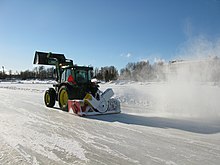
Back Sněhová fréza Czech Sneslynge Danish Schneefräse German Εκχιονιστικό μηχάνημα Greek Neĝoblovilo Esperanto برفخور Persian Lumilinko Finnish Souffleuse à neige French Ձյունամաքրիչ Armenian Penyapu salju ID





A snow blower or snowblower or snow thrower is a machine for removing snow from an area where it is problematic, such as a driveway, sidewalk, roadway, railroad track, ice rink, or runway. The commonly used term "snow blower" is a misnomer, as the snow is moved using an auger or impeller instead of being blown (by air). It can use either electric power (line power or battery), or a gasoline or diesel engine to throw snow to another location or into a truck to be hauled away. This is in contrast with the action of snow plows, which push snow to the front or side. Typically, the snow is discharged to one side, but most snow throwers have a movable chute that can direct snow across the full 180 degrees of motion in front of the appliance.
Snow blowers range from the very small, capable of removing only a few inches (a few more cm) of light snow in an 18 to 20 in (457 to 508 mm) path, to the very large, mounted onto heavy-duty winter service vehicles and capable of moving 20-foot (6.10 m) wide, or wider, swaths of heavy snow up to 6 feet (1.83 m) deep.
Snow blowers can generally be divided into two classes: single-stage and two-stage. On a single-stage snow blower, the auger (the paddle mechanism visible from the front) pulls snow into the machine and directs it out of a discharge chute. The auger contacts the ground, making single-stage snow blowers unsuitable for use on unpaved surfaces. On a two-stage snow blower, the auger pulls snow into the machine and feeds it into a high-speed impeller, which in turn directs it out of a discharge chute. Two-stage snow blowers can generally handle deeper snow depths than single-stage ones, and because their augers don't touch the ground, they can be used on unpaved surfaces.
Depending on the design, snowblowers can be pressed into service throwing other things, such as water.[1]
- ^ "Springtime flooding in Canada: What you need to know". The Globe and Mail. 25 April 2019. Retrieved 25 April 2019.